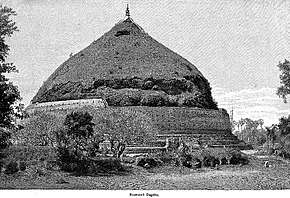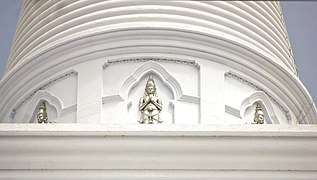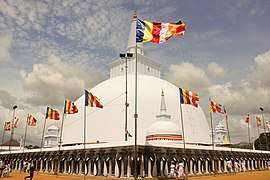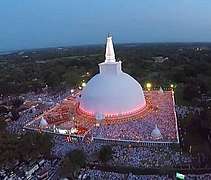Ruwanwelisaya
The Ruwanwelisaya is a stupa and a hemispherical structure containing relics, in Sri Lanka, considered sacred to many Buddhists all over the world.[1] Two quarts or one Drona of the Gothama Buddha's relics are enshrined in the stupa, which is the largest collection of his relics anywhere.[2] It was built by King Dutugemunu[3] c. 140 B.C., who became King of all Sri Lanka after a war in which the Chola King Elāra (Ellalan) was defeated. It is also known as "Mahathupa", "Swarnamali Chaitya", "Suvarnamali Mahaceti" (in Pali) and "Rathnamali Dagaba".
| Ruwanweli Maha Seya | |
|---|---|
රුවන්වැලිසෑය | |
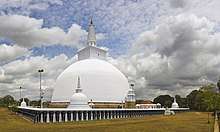 The Ruwanwelisaya Stupa | |
| Religion | |
| Affiliation | Theravada Buddhism |
| Location | |
| Country | Sri Lanka |
 Location in Sri Lanka | |
| Geographic coordinates | 8°21′0″N 80°23′47″E |
| Architecture | |
| Founder | King Dutugamunu |
| Completed | circa 140 BC |
This is one of the "Solosmasthana" (the 16 places of veneration) and the "Atamasthana" (the 8 places of veneration in the ancient sacred city of Anuradhapura). The stupa is one of the world's tallest ancient monuments, standing at 103 m (338 ft) and with a circumference of 290 m (951 ft). The original stupa had been about 55 m (180 ft) in height and was renovated by many kings.[4]The Kaunghmudaw Pagoda in Sagaing, Myanmar is modelled after this stupa.[5] The Mahavamsa contains a detailed account on the construction and the opening ceremony of the stupa.
The stupa was a ruin in the 19th century. After fundraising efforts by a Sinhalese bhikkhu, it was renovated in the early 20th century.[6] The Ruwanveli Seya Restoration Society was founded in 1902 and the final crowning of the stupa took place on 17 June 1940.[6]
Buddha’s Relic
After The Buddha's Mahaparinibbāna, His relics were enshrined and revered in stupas by princes of eight countries two quarts in each country. The two quarts of relics that were enshrined in the village Rāmagāma were, according to The Buddha’s determination, destined to be enshrined in the Great Stūpa Ruvanveli. King Dutthagamini (often spelled as Dutugemunu) who, on the full-moon day of the month of Āsāḷha (June–July), under the constellation of ‘‘Uttarāsāḷha’’, would officiate in the ceremony for the enshrining of the relics in the Great Stūpa, worshipped the Sangha (Order of monks) on the day before the full-moon day, reminded them that tomorrow is the appointed day for the enshrining of the relics and requested them to give him the relics. The Saṅgha ordered then the novice Arahant Soṇuttara, who was gifted with the six supernormal faculties, to procure the relics from Naga-Loka realm, which Arahant Soṇuttara manages to visit and bring and offer to the Sangha.
Then king Dutthagamini received from the Sangha the Buddha’s relics upon his head in a casket and departed from the golden pavilion in the midst of manifold offerings and honours made by gods and ‘‘Brahmas’’. He circumambulated the relic-chamber three times, entered to it from the east, and when laid the relic-casket on a silver couch one ‘‘koṭi’’ worth, that was arranged in the north side. An image of the Buddha was then, according to the Buddha’s determination, created in the lion’s reclining posture (‘‘sīhaseyya’’), and all the relics were enshrined within that image. When the enshrining of the relics in the Great Stūpa Ruvanveli was completed, the two novices Uttara and Sumana closed the relic-chamber with the stone-blocks that were previously hidden to be used as a lid.
In the Thupavamsa numerous types of beings attended the enshrinement of the relics into the Mahathupa; including the Naga king Mahakala who until recently guarded them. The relics were to be placed atop a golden throne crafted by Visvakarman the divine artificer; the throne brought by Indra. Brahma offers his invisible umbrella of sovereignty, with the king Dutthagamani offering his own. The arhat Indagutta creates a metal canopy over the universe, so that Mara will not interfere, as monks chanted the Sutta Pitaka (the Collection of Discourses delivered by the Buddha). Dutthagamani ceremoniously enters with the urn atop his head; but as he is about to place the urn on the golden throne, the relics rise into the air and form Buddha, with each of the 32 major signs and 80 lesser signs of a great man. In this form he performs the twin miracle of fire and water, fulfilling the fifth of his death bed resolutions. One hundred and twenty million gods and humans gain arhatship from this experience. The relics return to the urn and they are laid to rest and the chamber sealed with forty meter stone slabs.[7]
‘‘"The relic-chamber shall not shake even by an earthquake; flowers such as jasmine that were offered on that day shall not wither till the end of Buddha Gotama’s Dispensation; the lamps that were kindled with ghee-oil shall not be extinguished; the clay that was mixed with perfume and sandalwood shall not dry; even a single scratch shall not appear within the relic-chamber; stains shall not appear in any of the golden goods that were offered.’ All this occurred by the determination-power of all Arahants present. They determined also that inimical persons should not be able to even see the relic-chamber. Furthermore, by order of king Dutugemunu, the people of Srī Lanka enshrined, along with many other objects such as golden and silver caskets, thousand more of the Buddha's relics over the relic-chamber."
Images
See also
- Ancient stupas of Sri Lanka
- List of tallest structures built before the 20th century
- Ancient Constructions of Sri Lanka
- Architecture of ancient Sri Lanka
- Architecture of Sri Lanka
- Jetavanaramaya
- Atamasthana
- Mahawansa
References
- "Ruwanweliseya". Sri Lanka Heritages. com. Retrieved 25 September 2015.
- https://www.pressreader.com/sri-lanka/sunday-times-sri-lanka/20191208/283029761483692
- Mahanama Bhukkhu. Mahavamsa.
- "Ruwanweli Maha Seya". Retrieved 29 August 2018.
- Myo Aung and H. Kraft’. Upper Myanmar Mandalay Pyin Oo Lwin Sagaing Monywa Mingun Mogok Shwebo. Books on Asia.
- Swarnamali Maha Seya and the forgotten monk, July 13, 2012
- John S. Strong (2007). Relics of the Buddha. pp. 160–171.
Bibliography
- Shereen Amendra, "Beyond the Seeing Eye: The Mahathupa of Lanka: An Insight", Shereen Amendra, 2006, ISBN 9555009805
- Ulrich von Schroeder, "Buddhist Sculptures of Sri Lanka", Visual Dharma Publications, 1990, ISBN 962-7049-05-0
External links
| Wikimedia Commons has media related to Ruwanwelisaya. |
